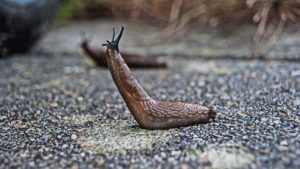Slugs & Snails
go.ncsu.edu/readext?606789
en Español / em Português
El inglés es el idioma de control de esta página. En la medida en que haya algún conflicto entre la traducción al inglés y la traducción, el inglés prevalece.
Al hacer clic en el enlace de traducción se activa un servicio de traducción gratuito para convertir la página al español. Al igual que con cualquier traducción por Internet, la conversión no es sensible al contexto y puede que no traduzca el texto en su significado original. NC State Extension no garantiza la exactitud del texto traducido. Por favor, tenga en cuenta que algunas aplicaciones y/o servicios pueden no funcionar como se espera cuando se traducen.
Português
Inglês é o idioma de controle desta página. Na medida que haja algum conflito entre o texto original em Inglês e a tradução, o Inglês prevalece.
Ao clicar no link de tradução, um serviço gratuito de tradução será ativado para converter a página para o Português. Como em qualquer tradução pela internet, a conversão não é sensivel ao contexto e pode não ocorrer a tradução para o significado orginal. O serviço de Extensão da Carolina do Norte (NC State Extension) não garante a exatidão do texto traduzido. Por favor, observe que algumas funções ou serviços podem não funcionar como esperado após a tradução.
English
English is the controlling language of this page. To the extent there is any conflict between the English text and the translation, English controls.
Clicking on the translation link activates a free translation service to convert the page to Spanish. As with any Internet translation, the conversion is not context-sensitive and may not translate the text to its original meaning. NC State Extension does not guarantee the accuracy of the translated text. Please note that some applications and/or services may not function as expected when translated.
Collapse ▲Slugs and snails are much like some insects in their biology. Their damage to ornamental plants resembles that done by caterpillars or wireworms.
Approximately 725 species of land snails and about 40 species of slugs are now known from North America. Most of these have been introduced accidentally. With few exceptions, native species are solitary in habit and do little or no damage. The introduced slugs and snails are usually gregarious and may cause serious damage as they can build up large populations in a local area.
Slugs and snails are usually nocturnal so their damage is noticed before the pests are. They leave silvery slime trails on the ground and over plants. Slugs are able to crawl over the sharp edge of a razor blade without harm. Slugs and snails may consume several times their own body weight each night, so damage can be serious within a short time.
Slugs are apparently not repelled by light but are repelled by rising temperatures. As temperatures rise, slugs crawl down to their hiding places on the soil surface to rest and absorb water through their skin. As temperatures start to fall, slugs actively begin foraging. Slugs may be active during the day after a cooling shower as long as the temperatures decline or remain steady.
Birds, ducks, moles, toads, shrews, various beetles feed on slugs. There are also some flies and nematodes that parasitize slugs. Dry weather may kill up to 90% of slug eggs and young per year.
You have a few non-toxic options for control of snails & slugs. One is to put stale beer in a dish and sink it in the ground with the top of the dish level with the soil. The yeasts in the beer attract the slugs & they crawl in and drown. The second non-toxic method is to place a board on the ground where you are seeing damage to plants. The slugs will crawl under the board in the heat of the day and you can pick them & destroy. Copper sulfate is toxic to slugs and they will not crawl across a barrier of copper metal or wooden surfaces treated with copper sulfate. Metaldehyde is a poisonous bait whose toxic effects seem to be primarily due to dehydration because it causes excessive mucus production (mucus is 98 percent water).
Like any other pest in the garden, scouting and catching the problem early gives you the best chance for managing it.





